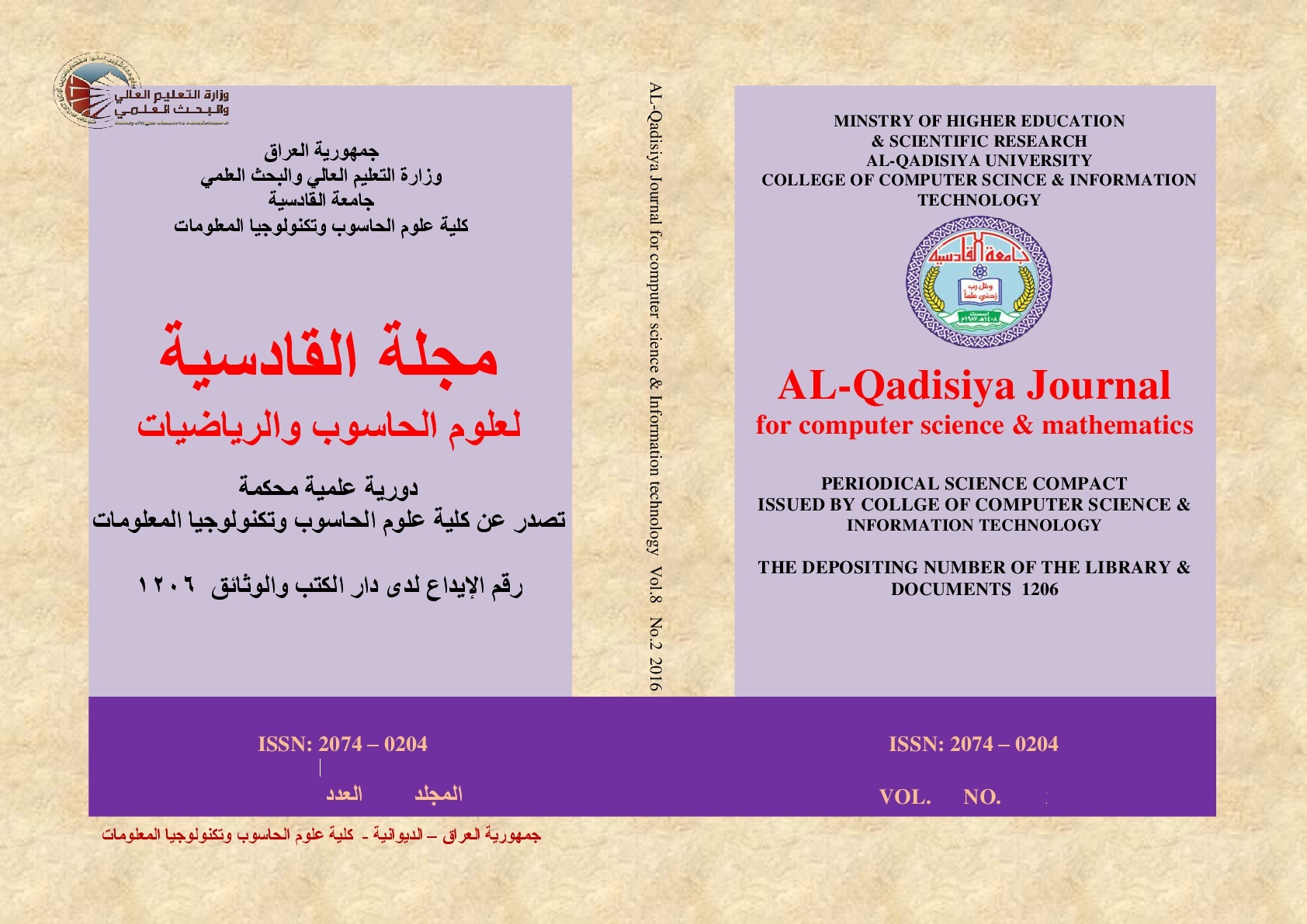A Review of Artificial Intelligence Methods for Diagnosing and Classifying Schizophrenia Using EEG Signals
DOI:
https://doi.org/10.29304/jqcsm.2025.17.22173Keywords:
Schizophrenia (SZ), Deep Learning (DL), Electroencephalography (EEG)Abstract
Schizophrenia (SZ) is a chronic and severe mental disorder characterized by impairments in cognitive skills, perceptions, emotions, and social interactions. A timely and accurate diagnosis is crucial for improving prognosis and developing effective treatment strategies. Recently, researchers have utilized computational models to enhance the effectiveness and speed of schizophrenia diagnosis using electroencephalogram (EEG), consequently reducing clinical workload. This research investigates the integration of traditional signal processing techniques, feature extraction methods, and artificial intelligence (AI), including machine learning (ML) and deep learning (DL), for the categorization of schizophrenia (SZ) utilizing EEG data. The electroencephalogram, a crucial tool for assessing cerebral activity, has demonstrated importance in mental health research. Upon acquiring brain data, various signal-processing techniques are employed to extract pertinent information from the temporal, frequency, and spatial domains. The gathered properties, encompassing mean, variance, and band power, are the basis for recognizing EEG signals. Traditional machine learning techniques, such as Decision Trees and Support Vector Machines (SVMs), provide interpretability and effectiveness with constrained datasets. In contrast, deep learning techniques, such as convolutional neural networks (CNNs) and extended short-term memory networks (LSTMs), excel in analyzing complex EEG patterns; however, they require extensive data and significant computational resources. The study examines the challenges associated with implementing AI in the diagnosis of schizophrenia, including ethical concerns and issues with data quality. These difficulties require collaborative and ethically sound approaches to ensure reliable advancement in the area. The research highlights the importance of employing many approaches to improve diagnosis accuracy, showcasing the potential of AI-driven solutions in the classification of schizophrenia. This review offers a comprehensive examination of contemporary literature, encompassing themes, approaches, and conclusions. The aim is to identify significant advancements and provide insights that help researchers and clinicians understand and tackle schizophrenia through innovative AI-driven approaches.
Downloads
References
M. A. Vázquez, A. Maghsoudi, and I. P. Mariño, “An Interpretable Machine Learning Method for the Detection of Schizophrenia Using EEG Signals,” Front Syst Neurosci, vol. 15, May 2021, doi: 10.3389/fnsys.2021.652662.
F. S. Racz, O. Stylianou, P. Mukli, and A. Eke, “Multifractal and Entropy-Based Analysis of Delta Band Neural Activity Reveals Altered Functional Connectivity Dynamics in Schizophrenia,” Front Syst Neurosci, vol. 14, p. 554337, Jul. 2020, doi: 10.3389/fnsys.2020.00049.
S. Siuly, Y. Guo, O. F. Alcin, Y. Li, P. Wen, and H. Wang, “Exploring deep residual network based features for automatic schizophrenia detection from EEG,” Phys Eng Sci Med, vol. 46, no. 2, pp. 561–574, Jun. 2023, doi: 10.1007/s13246-023-01225-8.
C. Zhuo et al., “The genomics of schizophrenia: Shortcomings and solutions,” Prog Neuropsychopharmacol Biol Psychiatry, vol. 93, pp. 71–76, Jul. 2019, doi: 10.1016/j.pnpbp.2019.03.009.
J. W. Lai, C. K. E. Ang, U. R. Acharya, and K. H. Cheong, “Schizophrenia: A Survey of Artificial Intelligence Techniques Applied to Detection and Classification,” Int J Environ Res Public Health, vol. 18, no. 11, p. 6099, Jun. 2021, doi: 10.3390/ijerph18116099.
G. Xu et al., “A Deep Transfer Convolutional Neural Network Framework for EEG Signal Classification,” IEEE Access, vol. 7, pp. 112767–112776, 2019, doi: 10.1109/ACCESS.2019.2930958.
M. Bracher-Smith et al., “Machine learning for prediction of schizophrenia using genetic and demographic factors in the UK biobank,” Schizophr Res, vol. 246, pp. 156–164, Aug. 2022, doi: 10.1016/j.schres.2022.06.006.
G. Li, D. Han, C. Wang, W. Hu, V. D. Calhoun, and Y.-P. Wang, “Application of deep canonically correlated sparse autoencoder for the classification of schizophrenia,” Comput Methods Programs Biomed, vol. 183, p. 105073, Jan. 2020, doi: 10.1016/j.cmpb.2019.105073.
K. Kim, N. T. Duc, M. Choi, and B. Lee, “EEG microstate features for schizophrenia classification,” PLoS One, vol. 16, no. 5, p. e0251842, May 2021, doi: 10.1371/journal.pone.0251842.
V. Jahmunah et al., “Automated detection of schizophrenia using nonlinear signal processing methods,” Artif Intell Med, vol. 100, p. 101698, Sep. 2019, doi: 10.1016/j.artmed.2019.07.006.
S. Siuly, S. Khare, V. Bajaj, … H. W.-I. T. on, and undefined 2020, “A computerized method for automatic detection of schizophrenia using EEG signals,” ieeexplore.ieee.orgS Siuly, SK Khare, V Bajaj, H Wang, Y ZhangIEEE Transactions on Neural Systems and Rehabilitation Engineering, 2020•ieeexplore.ieee.org, Accessed: Oct. 13, 2024. [Online]. Available: https://ieeexplore.ieee.org/abstract/document/9187840/
S. K. Prabhakar, H. Rajaguru, and S.-W. Lee, “A Framework for Schizophrenia EEG Signal Classification With Nature Inspired Optimization Algorithms,” IEEE Access, vol. 8, pp. 39875–39897, 2020, doi: 10.1109/ACCESS.2020.2975848.
M. Sharma and U. R. Acharya, “Automated detection of schizophrenia using optimal wavelet-based $$l_1$$ norm features extracted from single-channel EEG,” Cogn Neurodyn, vol. 15, no. 4, pp. 661–674, Aug. 2021, doi: 10.1007/s11571-020-09655-w.
M. Baygin, O. Yaman, T. Tuncer, S. Dogan, P. D. Barua, and U. R. Acharya, “Automated accurate schizophrenia detection system using Collatz pattern technique with EEG signals,” Biomed Signal Process Control, vol. 70, Sep. 2021, doi: 10.1016/j.bspc.2021.102936.
A. Keihani, S. S. Sajadi, M. Hasani, and F. Ferrarelli, “Bayesian Optimization of Machine Learning Classification of Resting-State EEG Microstates in Schizophrenia: A Proof-of-Concept Preliminary Study Based on Secondary Analysis,” Brain Sci, vol. 12, no. 11, Nov. 2022, doi: 10.3390/brainsci12111497.
M. Agarwal and A. Singhal, “Fusion of pattern-based and statistical features for Schizophrenia detection from EEG signals,” Med Eng Phys, vol. 112, p. 103949, Feb. 2023, doi: 10.1016/j.medengphy.2023.103949.
J. Ruiz de Miras, A. J. Ibáñez-Molina, M. F. Soriano, and S. Iglesias-Parro, “Schizophrenia classification using machine learning on resting state EEG signal,” Biomed Signal Process Control, vol. 79, p. 104233, Jan. 2023, doi: 10.1016/j.bspc.2022.104233.
T. S. Kumar, K. N. V. P. S. Rajesh, S. Maheswari, V. Kanhangad, and U. R. Acharya, “Automated Schizophrenia detection using local descriptors with EEG signals,” Eng Appl Artif Intell, vol. 117, Jan. 2023, doi: 10.1016/j.engappai.2022.105602.
B. Gosala, P. Dindayal Kapgate, P. Jain, R. Nath Chaurasia, and M. Gupta, “Wavelet transforms for feature engineering in EEG data processing: An application on Schizophrenia,” Biomed Signal Process Control, vol. 85, p. 104811, Aug. 2023, doi: 10.1016/j.bspc.2023.104811.
A. Alazzawı et al., “Schizophrenia diagnosis based on diverse epoch size resting-state EEG using machine learning,” PeerJ Comput Sci, vol. 10, p. e2170, Aug. 2024, doi: 10.7717/peerj-cs.2170.
A. Elfarsy and S. El-Metwally, “Leveraging EEG Signals and Machine Learning for Schizophrenia Classification,” in 2024 6th International Conference on Computing and Informatics (ICCI), IEEE, Mar. 2024, pp. 23–27. doi: 10.1109/ICCI61671.2024.10485176.
S. L. Oh, J. Vicnesh, E. J. Ciaccio, R. Yuvaraj, and U. R. Acharya, “Deep Convolutional Neural Network Model for Automated Diagnosis of Schizophrenia Using EEG Signals,” Applied Sciences, vol. 9, no. 14, p. 2870, Jul. 2019, doi: 10.3390/app9142870.
A. Shalbaf, S. Bagherzadeh, and A. Maghsoudi, “Transfer learning with deep convolutional neural network for automated detection of schizophrenia from EEG signals,” Phys Eng Sci Med, vol. 43, no. 4, pp. 1229–1239, Dec. 2020, doi: 10.1007/s13246-020-00925-9.
S. K. Khare, V. Bajaj, and U. R. Acharya, “SPWVD-CNN for Automated Detection of Schizophrenia Patients Using EEG Signals,” IEEE Trans Instrum Meas, vol. 70, pp. 1–9, 2021, doi: 10.1109/TIM.2021.3070608.
H. Akbari, S. Ghofrani, P. Zakalvand, and M. Tariq Sadiq, “Schizophrenia recognition based on the phase space dynamic of EEG signals and graphical features,” Biomed Signal Process Control, vol. 69, p. 102917, Aug. 2021, doi: 10.1016/j.bspc.2021.102917.
J. Sun et al., “A hybrid deep neural network for classification of schizophrenia using EEG Data,” Sci Rep, vol. 11, no. 1, p. 4706, Feb. 2021, doi: 10.1038/s41598-021-83350-6.
S. Bagherzadeh, M. S. Shahabi, and A. Shalbaf, “Detection of schizophrenia using a hybrid of deep learning and brain effective connectivity image from electroencephalogram signal,” Comput Biol Med, vol. 146, p. 105570, Jul. 2022, doi: 10.1016/j.compbiomed.2022.105570.
R. Supakar, P. Satvaya, and P. Chakrabarti, “A deep learning-based model using RNN-LSTM for the Detection of Schizophrenia from EEG data,” Comput Biol Med, vol. 151, p. 106225, Dec. 2022, doi: 10.1016/j.compbiomed.2022.106225.
Z. Aslan and M. Akin, “A deep learning approach in automated detection of schizophrenia using scalogram images of EEG signals,” Phys Eng Sci Med, vol. 45, no. 1, pp. 83–96, Mar. 2022, doi: 10.1007/s13246-021-01083-2.
D. W. Ko and J. J. Yang, “EEG-Based Schizophrenia Diagnosis through Time Series Image Conversion and Deep Learning,” Electronics (Switzerland), vol. 11, no. 14, Jul. 2022, doi: 10.3390/electronics11142265.
M. Shen, P. Wen, B. Song, and Y. Li, “Automatic identification of schizophrenia based on EEG signals using dynamic functional connectivity analysis and 3D convolutional neural network,” Comput Biol Med, vol. 160, p. 107022, Jun. 2023, doi: 10.1016/j.compbiomed.2023.107022.
S. Bhadra, C. J. Kumar, and D. K. Bhattacharyya, “Multiview EEG signal analysis for diagnosis of schizophrenia: an optimized deep learning approach,” Multimed Tools Appl, Sep. 2024, doi: 10.1007/s11042-024-20205-y.
M. Hu et al., “Structural and diffusion MRI-based schizophrenia classification using 2D pretrained and 3D naive Convolutional Neural Networks,” Schizophr Res, vol. 243, no. June, pp. 330–341, 2022, doi: 10.1016/j.schres.2021.06.011.
J. Rahul, D. Sharma, L. D. Sharma, U. Nanda, and A. K. Sarkar, “A systematic review of EEG-based automated schizophrenia classification through machine learning and deep learning,” Front Hum Neurosci, vol. 18, p. 1347082, Feb. 2024, doi: 10.3389/FNHUM.2024.1347082/BIBTEX.
W. Yassin et al., “Machine-learning classification using neuroimaging data in schizophrenia, autism, ultra-high risk and first-episode psychosis,” Transl Psychiatry, vol. 10, no. 1, p. 278, Aug. 2020, doi: 10.1038/s41398-020-00965-5.
M. Luján, M. Jimeno, J. Mateo Sotos, J. Ricarte, and A. Borja, “A Survey on EEG Signal Processing Techniques and Machine Learning: Applications to the Neurofeedback of Autobiographical Memory Deficits in Schizophrenia,” Electronics (Basel), vol. 10, no. 23, p. 3037, Dec. 2021, doi: 10.3390/electronics10233037.
Z. Rustam and G. S. Saragih, “Prediction schizophrenia using random forest,” TELKOMNIKA (Telecommunication Computing Electronics and Control), vol. 18, no. 3, p. 1433, Jun. 2020, doi: 10.12928/telkomnika.v18i3.14837.
G. Li, D. Han, C. Wang, W. Hu, V. D. Calhoun, and Y.-P. Wang, “Application of deep canonically correlated sparse autoencoder for the classification of schizophrenia,” Comput Methods Programs Biomed, vol. 183, p. 105073, Jan. 2020, doi: 10.1016/j.cmpb.2019.105073.
M. Yadava, P. Kumar, R. Saini, P. P. Roy, and D. Prosad Dogra, “Analysis of EEG signals and its application to neuromarketing,” Multimed Tools Appl, vol. 76, no. 18, pp. 19087–19111, Sep. 2017, doi: 10.1007/s11042-017-4580-6.
I. J. Rampil, “A Primer for EEG Signal Processing in Anesthesia Introduction-The Rationale for Monitoring,” 1998.
J. M. Ford, V. A. Palzes, B. J. Roach, and D. H. Mathalon, “Did I Do That? Abnormal Predictive Processes in Schizophrenia When Button Pressing to Deliver a Tone,” Schizophr Bull, vol. 40, no. 4, pp. 804–812, Jul. 2014, doi: 10.1093/schbul/sbt072.
J. P. Pijn, J. Van Neerven, A. Noest, and F. H. Lopes da Silva, “Chaos or noise in EEG signals; dependence on state and brain site,” Electroencephalogr Clin Neurophysiol, vol. 79, no. 5, pp. 371–381, Nov. 1991, doi: 10.1016/0013-4694(91)90202-F.
B. Boashash and G. Azemi, “A review of time–frequency matched filter design with application to seizure detection in multichannel newborn EEG,” Digit Signal Process, vol. 28, pp. 28–38, May 2014, doi: 10.1016/j.dsp.2014.02.007.
S. Golestan, M. Ramezani, J. M. Guerrero, F. D. Freijedo, and M. Monfared, “Moving Average Filter Based Phase-Locked Loops: Performance Analysis and Design Guidelines,” IEEE Trans Power Electron, vol. 29, no. 6, pp. 2750–2763, Jun. 2014, doi: 10.1109/TPEL.2013.2273461.
I. Guyon and A. Elisseeff, “An Introduction to Feature Extraction,” in Feature Extraction, Berlin, Heidelberg: Springer Berlin Heidelberg, pp. 1–25. doi: 10.1007/978-3-540-35488-8_1.
S. Capuozzo et al., “Automating parasite egg detection: insights from the first AI-KFM challenge,” Front Artif Intell, vol. 7, Aug. 2024, doi: 10.3389/frai.2024.1325219.
L. Hu and Z. Zhang, Eds., EEG Signal Processing and Feature Extraction. Singapore: Springer Singapore, 2019. doi: 10.1007/978-981-13-9113-2.
S. Guo, J. Wu, M. Ding, and J. Feng, “Uncovering Interactions in the Frequency Domain,” PLoS Comput Biol, vol. 4, no. 5, p. e1000087, May 2008, doi: 10.1371/journal.pcbi.1000087.
V. K. Rai and A. R. Mohanty, “Bearing fault diagnosis using FFT of intrinsic mode functions in Hilbert–Huang transform,” Mech Syst Signal Process, vol. 21, no. 6, pp. 2607–2615, Aug. 2007, doi: 10.1016/j.ymssp.2006.12.004.
K. T. Tapani, S. Vanhatalo, and N. J. Stevenson, “Time-Varying EEG Correlations Improve Automated Neonatal Seizure Detection,” Int J Neural Syst, vol. 29, no. 04, p. 1850030, May 2019, doi: 10.1142/S0129065718500302.
S. A. Neild, P. D. McFadden, and M. S. Williams, “A review of time-frequency methods for structural vibration analysis,” Eng Struct, vol. 25, no. 6, pp. 713–728, May 2003, doi: 10.1016/S0141-0296(02)00194-3.
M. Rezapour and S. K. Elmshaeuser, “Artificial intelligence-based analytics for impacts of COVID-19 and online learning on college students’ mental health,” PLoS One, vol. 17, no. 11, p. e0276767, Nov. 2022, doi: 10.1371/journal.pone.0276767.
B. Scholkopf et al., “Comparing support vector machines with Gaussian kernels to radial basis function classifiers,” IEEE Transactions on Signal Processing, vol. 45, no. 11, pp. 2758–2765, 1997, doi: 10.1109/78.650102.
A. E. Maxwell, T. A. Warner, and F. Fang, “Implementation of machine-learning classification in remote sensing: an applied review,” Int J Remote Sens, vol. 39, no. 9, pp. 2784–2817, May 2018, doi: 10.1080/01431161.2018.1433343.
N. S. Bastos, B. P. Marques, D. F. Adamatti, and C. Z. Billa, “Analyzing EEG Signals Using Decision Trees: A Study of Modulation of Amplitude,” Comput Intell Neurosci, vol. 2020, pp. 1–11, Jul. 2020, doi: 10.1155/2020/3598416.
W. Wu et al., “Comparison of regularized discriminant analysis linear discriminant analysis and quadratic discriminant analysis applied to NIR data,” Anal Chim Acta, vol. 329, no. 3, pp. 257–265, Aug. 1996, doi: 10.1016/0003-2670(96)00142-0.
T. C. de Brito Guerra, T. Nóbrega, E. Morya, A. de M. Martins, and V. A. de Sousa, “Electroencephalography Signal Analysis for Human Activities Classification: A Solution Based on Machine Learning and Motor Imagery,” Sensors, vol. 23, no. 9, p. 4277, Apr. 2023, doi: 10.3390/s23094277.
A. Chahal* and P. Gulia, “Machine Learning and Deep Learning,” International Journal of Innovative Technology and Exploring Engineering, vol. 8, no. 12, pp. 4910–4914, Oct. 2019, doi: 10.35940/ijitee.L3550.1081219.
E. Ueda, Y. Hirohata, T. Hino, and T. Yamashina, “Lower limit of pressure measurement using a spinning rotor gauge,” Vacuum, vol. 44, no. 5–7, pp. 587–589, May 1993, doi: 10.1016/0042-207X(93)90102-G.
A. C. Tsoi, “Recurrent neural network architectures: An overview,” 1998, pp. 1–26. doi: 10.1007/BFb0053993.
R. Yamashita, M. Nishio, R. Kinh, G. Do, and K. Togashi, “Convolutional neural networks : an overview and application in radiology,” pp. 611–629, 2018.
Mohan Patro and M. Ranjan Patra, “A Novel Approach to Compute Confusion Matrix for Classification of n-Class Attributes with Feature Selection,” Transactions on Machine Learning and Artificial Intelligence, Apr. 2015, doi: 10.14738/tmlai.32.1108.
D. W. Betebenner, Y. Shang, Y. Xiang, Y. Zhao, and X. Yue, “The Impact of Performance Level Misclassification on the Accuracy and Precision of Percent at Performance Level Measures,” J Educ Meas, vol. 45, no. 2, pp. 119–137, Jun. 2008, doi: 10.1111/j.1745-3984.2007.00056.x.
A. P. Bradley, “The use of the area under the ROC curve in the evaluation of machine learning algorithms,” Pattern Recognit, vol. 30, no. 7, pp. 1145–1159, Jul. 1997, doi: 10.1016/S0031-3203(96)00142-2.
Downloads
Published
How to Cite
Issue
Section
License
Copyright (c) 2025 Abeer Saleh Alian, Firas Sabar Miften

This work is licensed under a Creative Commons Attribution-NonCommercial-NoDerivatives 4.0 International License.













